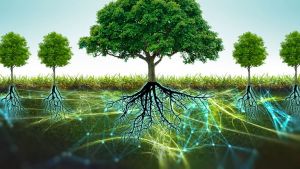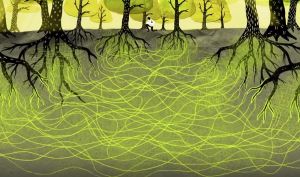Mycelium: Difference between revisions
Florez4747 (talk | contribs) |
Florez4747 (talk | contribs) |
||
| Line 23: | Line 23: | ||
<blockquote>Mycorestoration is the use of fungi to repair or restore the weakened immune systems of environments. Whether habitats have been damaged by human activity or natural disaster, saprophytic, endophytic, mycorrhizal, and in some cases parasitic fungi can aid recovery. As generations of mycelia cycle through a habitat, soil depth and moisture increase, enhancing the carrying capacity of the environment and the diversity of its members. <Ref>Paul Stamets, Mycelium Running, Page 55</Ref></blockquote> | <blockquote>Mycorestoration is the use of fungi to repair or restore the weakened immune systems of environments. Whether habitats have been damaged by human activity or natural disaster, saprophytic, endophytic, mycorrhizal, and in some cases parasitic fungi can aid recovery. As generations of mycelia cycle through a habitat, soil depth and moisture increase, enhancing the carrying capacity of the environment and the diversity of its members. <Ref>Paul Stamets, Mycelium Running, Page 55</Ref></blockquote> | ||
== Mycofiltration == | == Mycofiltration == | ||
Mycofiltration is the process of using Mycelium as a mechanism to filter water that is contaminated- often caused by livestock agriculture or other human contaminates. | |||
== Mycoforestry == | == Mycoforestry == | ||
Revision as of 22:06, 30 December 2022
Natural Intelligence
Understanding how mycelium works as an organism and the role it plays in our ecosystems has notably shaped how intelligence itself is defined.[1] As the neurological network of nature:
interlacing mosaics of mycelium infuse habitats with information-sharing membranes. These membranes are aware, react to change, and collectively have the long-term health of the host environment in mind. The mycelium stays in constant molecular communication with its environment, devising diverse enzymatic and chemical responses to complex challenges. [2]
The Mycelial archetype
Structures similar to Mycelium can be seen throughout Mother Earth and the universe. Some structures resembling Mycelial networks include patterns of hurricanes, dark matter and the internet, further Mycelial networks resemble patterns predicted by string theory. [3] **add photos of these examples**
Mycelium and the Environment
Habitats across the Earth depend upon Mycelium, a keystone species, to sustain themselves and their soils.[4] Mycelium hold soils together and help aerate them; Mycelium breaks down debris to build new blocks of soil after ecological catastrophes created by humans or otherwise. Mycelial networks partner with bacteria and other microorganisms to break down organic material creating stronger structures of soil. [5]
Mycelial Highways
Mycelium, specifically mycorrhizal fungi, partner with plants, microbes, and other animals below ground through its vast Mycelial network. Through this so called Mycelial Highway, chemicals released by one organism are able to quickly reach other organisms, increasing overall communication and resistance between all. Furthermore nutrients and water are transferred between Mycelial networks to deficient organisms.[6]
The mycelia of fungal species that form exterior sheaths around the roots of partner plants are termed ectomycorrhizal. The mycorrhizal fungi that invade the interior root cells of host plants are labeled endomycorrhizal... Both plant and mycorrhizae benefit from the association. Because ectomycorrhizal mycelium grows beyond the plant's roots, it brings distant nutrients and moisture to the host plant, extending the absorption zone well beyond the root structure. The mycelium dramatically increases the plant's ingestion of nutrients, nitrogenous compounds, and essential elements (phosphorus, copper, and zinc) as it decomposes surrounding debris... Plants with mycorhizal fungal partners can also resist diseases far better than those without. Fungi benefit from the relationship because it gives them access to plant-secreted sugars, mostly hexoses that the fungi convert to mannitols, arabitols, and erythritols. [7]
Mycelial networks are able to transport nutrients between different species of trees:
In one experiment, researchers compared the flow of nutrients via the mycelium between 3 trees: a Douglas fir (Pseudotsuga menziesii), a paper birch (Betula papyrifera), and a western red cedar (Thuja plicata). The Douglas fir and paper birch shared the same ectomycorrhiza, while the cedar had an endomycorrhiza (VAM). The researchers covered the Douglas fir to simulate deep shade, thus lowering the tree's ability to photosynthesize sugars. In response, the mycorrhizae channeled sugars, tracked by radioactive carbon, from the root zone of the birch to the root zone of the fir. More than 9 percent of the net carbon compounds transferred to the fir orginiated from the birch's roots, while the cedar recieved only a smlla fraction. The amount of sugar transferred was directly proportional to the amount of shading. [8]
Mycorestoration
The science behind Mycelium as a mechanism for environmental restoration has not been researched in an extensive manner, likely because of Mycophobia, but this provides new possibilities of reversing the destructive effects of climate collapse.
Mycorestoration is the use of fungi to repair or restore the weakened immune systems of environments. Whether habitats have been damaged by human activity or natural disaster, saprophytic, endophytic, mycorrhizal, and in some cases parasitic fungi can aid recovery. As generations of mycelia cycle through a habitat, soil depth and moisture increase, enhancing the carrying capacity of the environment and the diversity of its members. [9]
Mycofiltration
Mycofiltration is the process of using Mycelium as a mechanism to filter water that is contaminated- often caused by livestock agriculture or other human contaminates.
Mycoforestry
Mycoremediation
Mycopesticdes
Oil Spills
Mycophobia
The fear of mycelium (typically implicit) as usually manifested through a fear of their fruiting bodies (mushrooms) is known as mycophobia.
Sources
Pyrolize
"This Underground Economy Exists in a Secret Fungi Kingdom" (https://www.youtube.com/watch?v=WWD_1Nq6iwQ)
"Fungal Banking with Biochar and Hugelkultur" (https://www.youtube.com/watch?v=EoKS07Y1ASk)
"The Organic Internet of a Mycelium Network: Suzanne Simard, Paul Stamets, and Terence Mackenna" (https://www.youtube.com/watch?v=rGyECGJqWDU)
Cited
- ↑ https://microdose-journey.com/mycelium-networks/
- ↑ Mycelium Running, by Paul Stamets
- ↑ Paul Stamets, Mycelium Running, Page 9
- ↑ https://www.nature.com/articles/s41598-019-43980-3
- ↑ Paul Stamets, Mycelium Running, Page 11
- ↑ https://www.cell.com/trends/plant-science/fulltext/S1360-1385(12)00133-1?_returnURL=https%3A%2F%2Flinkinghub.elsevier.com%2Fretrieve%2Fpii%2FS1360138512001331%3Fshowall%3Dtrue
- ↑ Paul Stamets, Mycelium Running, Page 24
- ↑ Paul Stamets, Mycelium Running, Page 24-26
- ↑ Paul Stamets, Mycelium Running, Page 55

